I recently discussed a pair of figures from a Takara Tomy set featuring some unique fish species that are visually or culturally striking. Species that are notable for being scary looking, notorious, and somehow engaging for fishing (I think). I tried to translate the papers and it appears to be called World Fishing Monster Fish, but I can’t be certain. In any case, the set of four contains fish that are certainly unique-looking, and in many instances have been made notable through appearances on shows like River Monsters and, yes, Monster Fish, for their ferocity and difficulty in catching (side note, again, we need shows like these again). This particular fish is a bit of an outlier there, in that it certainly fits the bill as a potentially scary-looking fish, and maybe it is popular as an angling target, but I don’t think it showed up on any of the shows. It is the Kidako moray, Gymnothorax kidako.
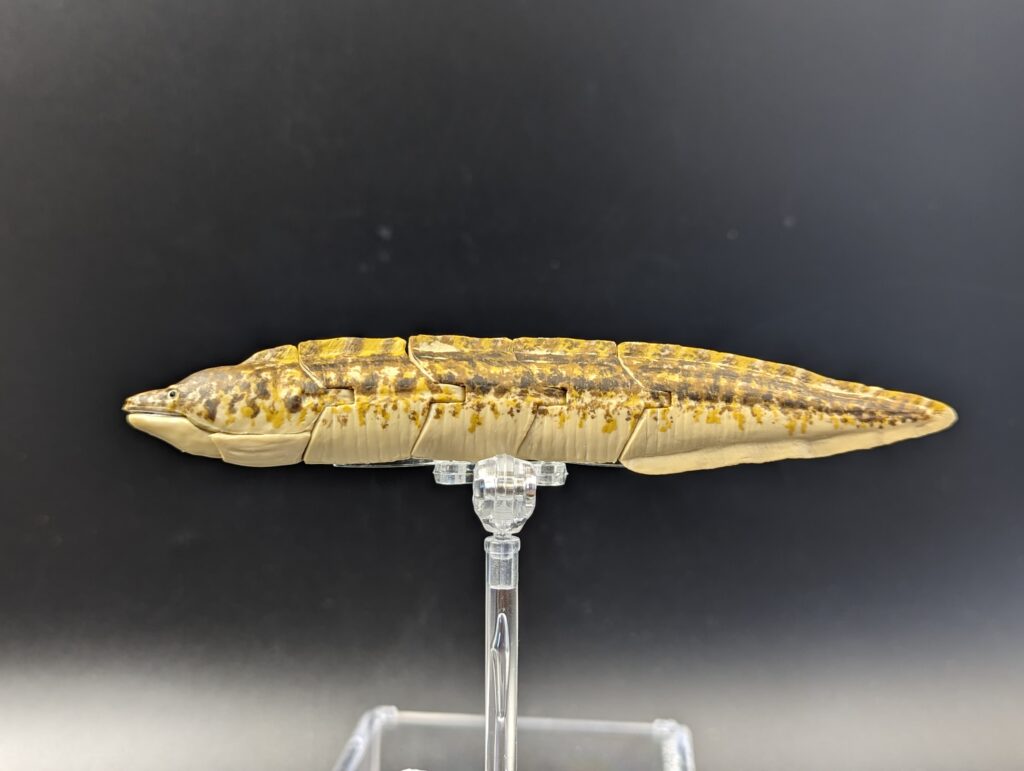
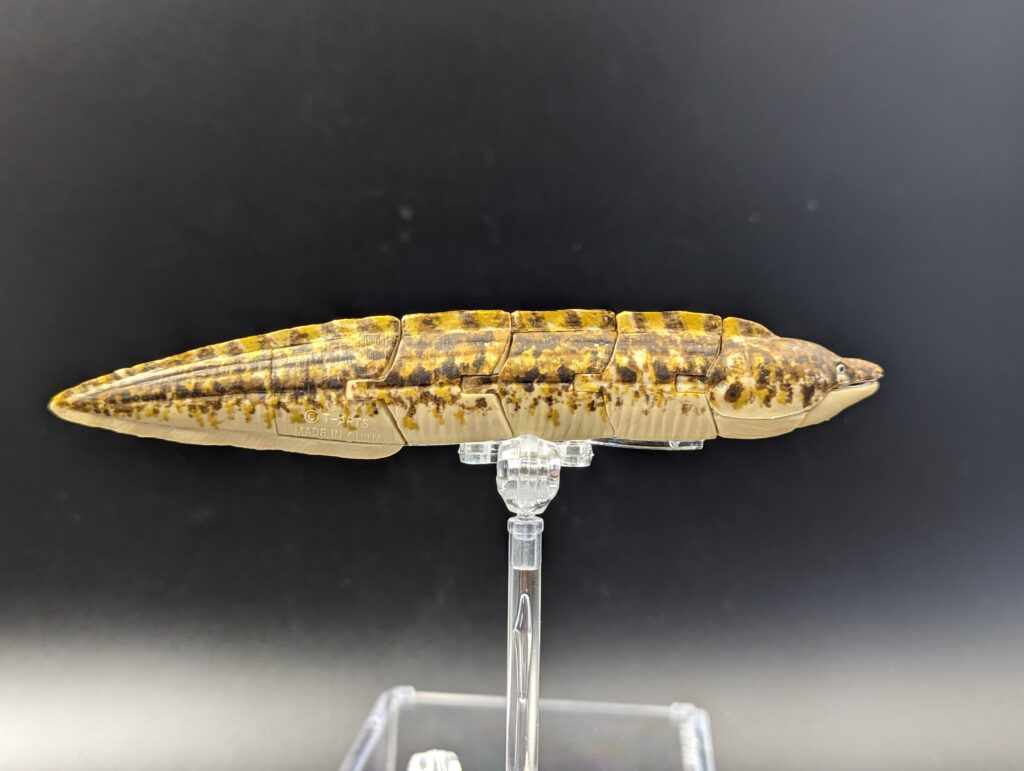
I don’t really need to go into great detail on the species as an earlier review of a different model covered the species well, the Enoshima Aquarium Aquatale Kidako moray. In short summary, it is a relatively familiar moray eel in Japan, often portrayed as a default ‘moray’ eel. It is notable for the striking yellow and black or brown banding, with whitish blotches or patches similar to those on other morays like the snowflake eel. They are found in warmer waters of the west Pacific ocean, preferring reefs and lagoons. It is a diurnal species unlike many morays, and preys on fish and cephalopods. Despite the fierce appearance, they are generally more likely to flee or hide than attack people unless handled or harassed (for example, when caught while fishing?)
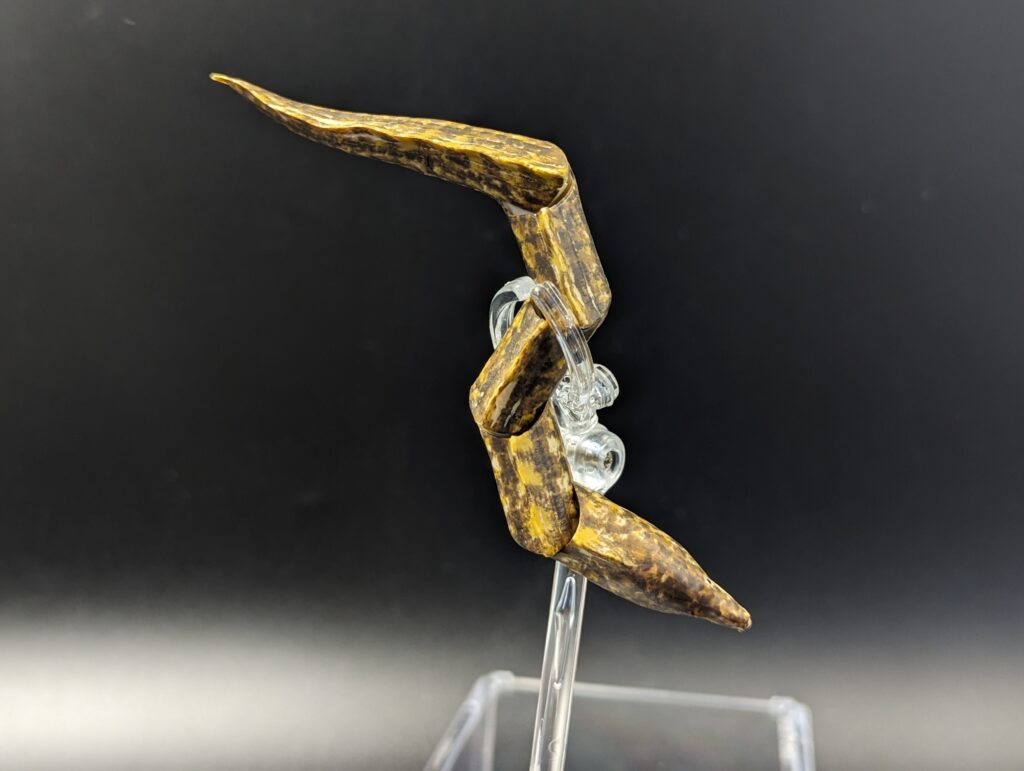
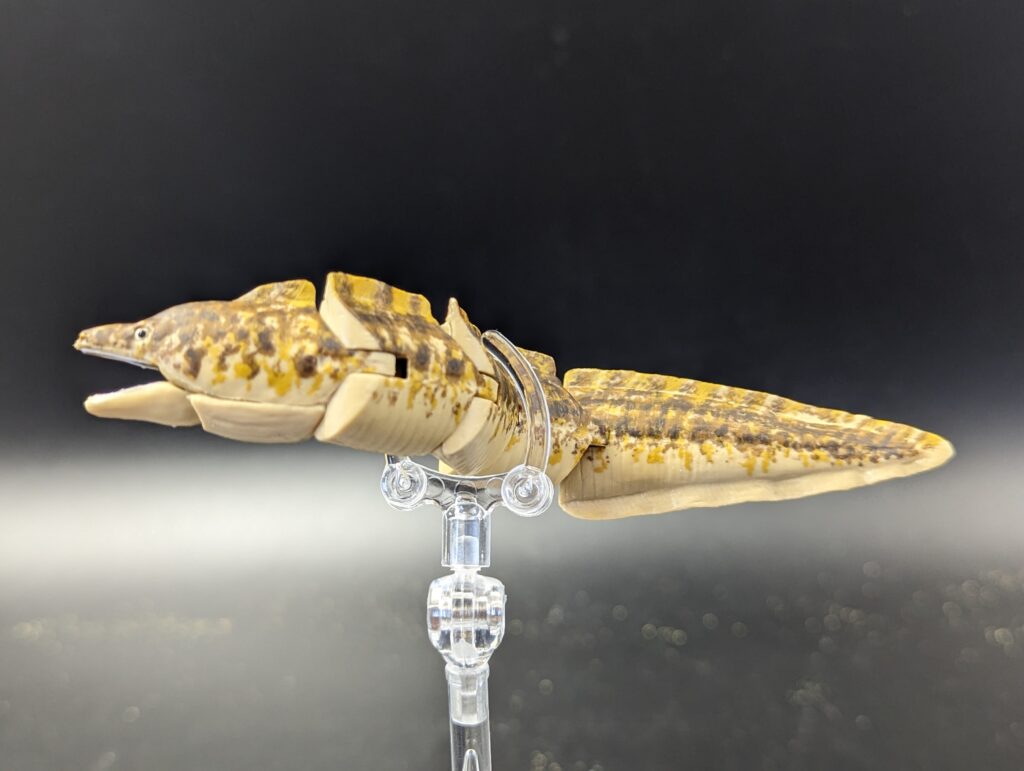
I’ve also described the Fishing Monster set style when describing the Goliath tigerfish before, so I can be brief on that as well. As with those and other similar Takara models, the figure is made of a softer PVC-type material, in several pieces that allows for articulation. The Kidako moray is made up of a head segment with a separate, movable lower jaw; three body segments, and a long tail segment. Sadly, the mouth is a single lever, with only the lower jaw moving; it would have been great to see them put more effort into the jaw like on the tigerfish (and the other figure in the set, I’ll get to it!), with a more mobile jaw, or even with the secondary pharyngeal jaws coming slightly forward. Based on other figures I have from the company, they probably could have done it.
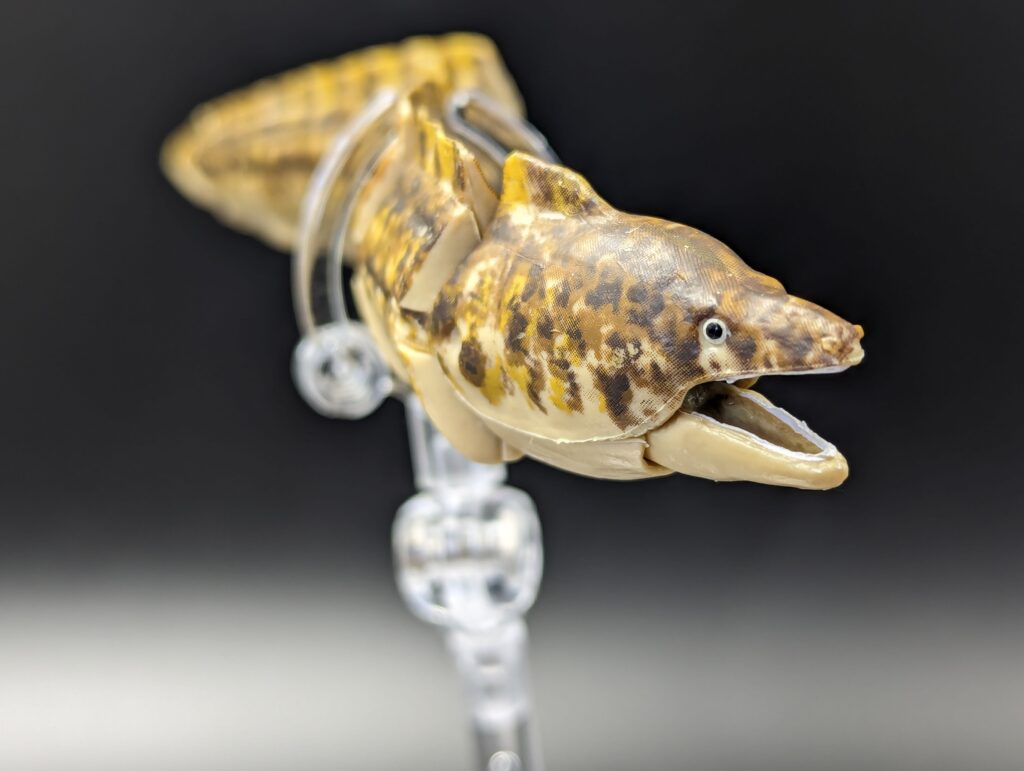
The base colour of the figure is a cream colour, with the sides covered in a random multitude of olive, gold, and black blotches. Overall, the colour placement appears quite haphazard and random; from what I can tell, most Kidako morays have the lighter gold to white base with mottled or snowflake-pattern bands down the back and sides. On this model the olive and black is especially dense on the dorsum and sides, the yellow blotches seem to extend in some parts below the halfway mark of the sides. Otherwise, the entire ventrum and lower jaw is completely uncoloured. The head is primarily the blotches of black and olive, with the eyes picked out clearly, with large, white sclera surrounding a large black pupil. This does a great job of depicting the famous look of a watchful moray eel.

The nostril tubules are also well depicted on the tip of the figure’s snout, all in the same colour pattern. The teeth are not sculpted clearly, instead depicted as a continuous, very white thin line around the edge of the mouth. No vomerine or palatine teeth are sculpted either. The ‘throat’, which is part of the first segment including the head, is sculpted with longitudinal folds, reminiscent of what is seen in moray eels as they expand their throats while resting and breathing. The gill, which on morays is a fairly small opening…is present as a small indentation, so that tracks. It appears to be uncoloured, so it stands out if you look for it.

The design of the body is such that all three mid-section pieces are the same shape and size, so can be placed in the body in any order. It does not appear to affect the consistency of the paint scheme. These three sections, as well as the head piece, are relatively tubular. The ventrum of the three middle sections are sculpted with transvers banded folds, indicate flexes and folds in the skin; this gives some indication of a larger, chunky eel. The tail section is quite long, easily the longest piece, much more laterally compressed than the other pieces, and rapidly narrows from anterior to posterior to a sharp point. The dorsal fin is sculpted as a thin, waving ridge across the top of the entire body, from the back of the head, across the three middle pieces, and along the entire tail section. It continues around the point of the tail section into the anal fin which extends to the anterior of the tail section. The dorsal fin is fully painted, whereas the entire anal fin, from the apex of the tail, is unpainted.
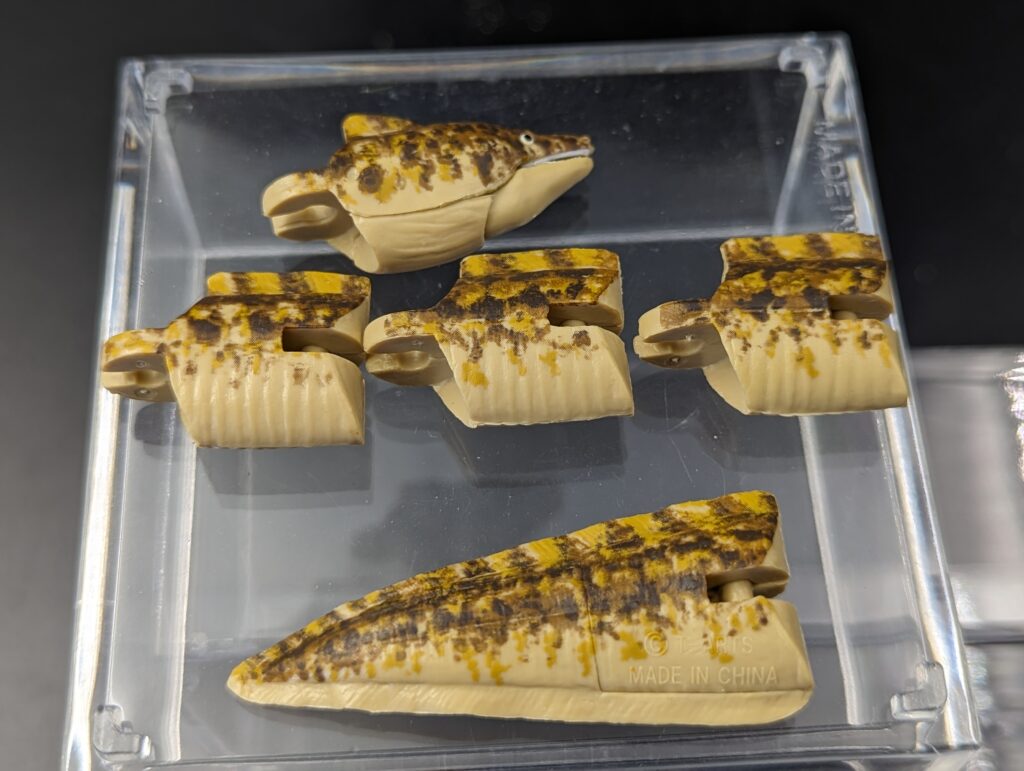
Overall, this figure does a reasonable job of representing a Kidako moray, although to be fair the species is not specifically named; this is, however, a popular Japanese species (also known there as the common moray) and the colour choices most likely reflect the species. That said, the random splotches are less effective at representing the species than if the dark patterns were more in a snowflake or starburst splatter pattern. As well, the anal fin is relatively deep, while it would usually be fairly thin (and seems to be coloured). The teeth are also not that representative; morays usually have fewer, longer teeth (to varying extents) that are present inside the mouth as well as along the edges; we saw sculpted teeth on the tiger fish, so it should have been possible. The biggest sticking point for many collectors will likely be the jointed pieces themselves; as they are quite thick, it is hard to display the figure in a way that minimizes the seams unless it is stock straight. The poseability is a neat feature, but it is a little distracting. It also makes it a little easier to get the figure to ‘stand’ on its own, an issue I have with the electric eel from the same company in an earlier set (ooh! I will review that at some point!). Overall, a good, larger figure, but certainly more toy than display (especially compared to the tiger fish…and the next/last figure I’ll review from the set). I’d recommend it, but the best model is still going to be that Kaiyodo one!

Disclaimer: links to Ebay and Amazon on the AnimalToyBlog are affiliate links, so we make a small commission if you use them. Thanks for supporting us!



